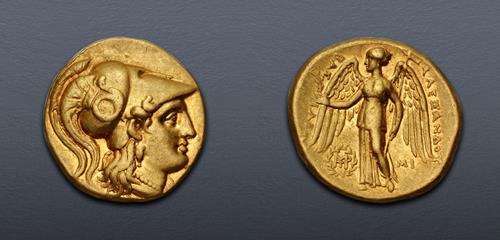
|
SELEUKID EMPIRE. Seleukos I Nikator. Second satrapy and kingship, 312-281 BC. AV Stater (18mm, 8.53 g, 2h). In the name and types of Alexander III of Macedon. Babylon I mint. Struck circa 311-300 BC. Near EF.
CNG Feature Auction 129
Lot: 304.
Closing Date: May 14 2025 11:00 ET
Greek, Gold
Estimate: $ 3 000
BID NOW
|
|
SELEUKID EMPIRE. Seleukos I Nikator. Second satrapy and kingship, 312-281 BC. AV Stater (18mm, 8.53 g, 2h). In the name and types of Alexander III of Macedon. Babylon I mint. Struck circa 311-300 BC. Helmeted head of Athena right / Nike standing left, holding wreath and stylis; monogram in wreath below left wing, MI below right wing. SC 81.1; Price 3745; HGC 9, 3a. Underlying luster, minor marks. Near EF.
From the G. Savonarola Collection. Ex CNG inventory 725603 (April 2001).
The Seleukid Empire was one of the main successor states to the Macedonian empire forged by Alexander III ‘the Great.’ Following Alexander’s death, his greatest generals, the Diadochs, divided the empire among themselves, but the settlement was not enduring and nearly constant warfare resulted from their ambitions to widen their respective areas of control. Seleukos I, despite being passed over in the initial settlement in 323 BC, received the satrapy of Babylon in the second settlement in 320 BC. By the time of his death in 281 BC, Seleukos had expanded his realm to encompass most of Alexander’s eastern possessions from Asia Minor to Baktria.
As with most of the other diadochs, Seleukos continued to strike coins in the name of Alexander, and he opened a number of new mints to serve his various campaigns and his growing empire. Shortly after assuming the royal title in 305 BC, Seleukos began issuing coinage in his own name and introduced a variety of new types that propagated the mythology of his new dynasty and celebrated his considerable accomplishments. Over the century following Seleukos’ death, though, the vast size of the empire proved unmanageable, and a number of local irredentist movements resulted in a growing number of breakaway regions, many of which also struck their own coinage. Internecine struggles, in conjunction with the growing power of Rome, were ultimately responsible for the final dissolution of the Seleukid empire in 64 BC. Over its nearly 250 years of existence, the Seleukid empire issued a vast quantity of coinage that was arguably the most diverse of all the Hellenistic kingdoms
The final winners of all CNG Feature Auction 129 lots will be determined during the live online sale that will be held on 13-14 May 2025. This lot is in Session One, which will begin 13 May at 9 AM ET.
Winning bids are subject to a 22.5% buyer's fee for bids placed on this website and 25% for all others.
We recognize that our users may have various Internet Browsers and Operating Systems. We like our visitors to have the best possible experience when using our bidding platform. However, we do recognize that it is impossible to develop applications that work identically, efficiently and effectively on all web browsers. The CNG bidding platform supports the latest stable major version and stable previous version of Chrome and Firefox.
|
